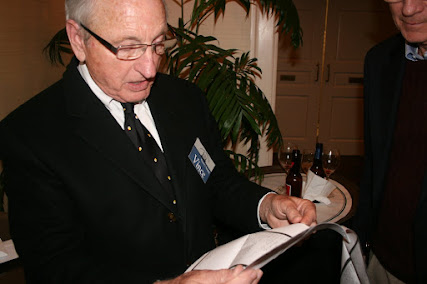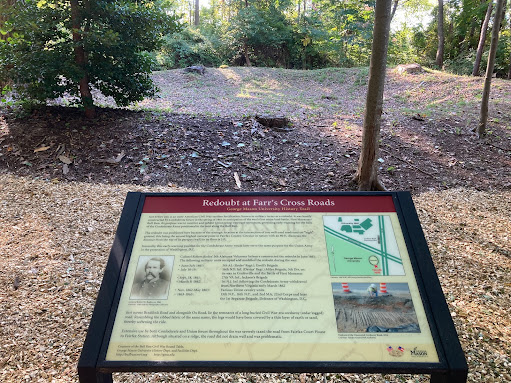 |
| With Ed Bearss in Athens, Ga., and Carolyn Turner in Newnan, Ga. (Skip Johnson, Charlie Crawford, GBA) |
Dooley, who died Friday at age 90, is being remembered, of course, for his sports
accomplishments: college football’s National
Championship in 1980 and six Southeastern Conference titles, among others. But he
immersed himself in other interests, including gardening, political science and history. The Marine Corps veteran was a philanthropist and mentor.
“The Civil War probably is the most critical time in our
history. It defined who we are,” Dooley told me in 2010. He later when on to write a book about a Georgia officer.
The Mobile, Ala., native had an ancestor who fought for the
Confederacy. Pvt. George Stanter (the surname shared by Dooley’s mother) served
with the 24th Alabama Infantry. Dooley
 |
| Dooley at a 2010 meeting of the Atlanta Civil War Roundtable (Picket photo) |
Gordon Jones, senior military historian and curator, Atlanta History Center:
What I respected most about Vince Dooley is that you would never know he was famous. When you met and talked with him, he was just an ordinary guy with an extraordinary interest in (and knowledge of) the Civil War. So it is with organizations like the (Atlanta) Civil War Roundtable – you know your friends not by their day jobs but by their particular historical interests. Someone at their first roundtable meeting would come up to me and say “Hey, isn’t that Vince Dooley?” and I’d reply, “Yeah it is. And we’re talking about Sherman.” His day job, however spectacular, was at that moment irrelevant. I love that. I think he did, too.
Charlie Crawford, president emeritus, Georgia Battlefields Association (Dooley was a GBA member and attended many tours):
I first met Coach in 2003 when I led an
Atlanta Campaign tour for him and his oldest grandson (then 16). He was
still UGA athletics director at the time and was frequently answering cell
phone calls relating to the status of student-athletes in all the sports:
women's basketball, women's gymnastics, swimming, baseball, equestrian,
etc. How many times did he make a decision about a young man or young
woman that affected their lives forever?
(It was) very enjoyable to watch the
interaction and listen to the collective wisdom when Coach was with Ed Bearss
and Bud Robertson, both of whom he knew very well. In addition to being a
premier historian, Bud had also been a college football official for 28 years
and officiated some Georgia games, including the last game that Vince coached.
(Against Michigan State in the 1988 Gator Bowl.)
.jpg) |
| With Jack Davis and Dan Hanks in Macon, Ga. (Charlie Crawford) |
Hard to predict his legacy relating to
preservation. Much as we can't know every way in which his example of discipline,
leadership, knowledge, fair play, love of learning and decency influenced the
thousands of men he coached, neither can we know every way in which those
qualities and his commitment to preservation have inspired (and will continue
to influence) anyone who saw him on a battlefield or heard him at an American
Battlefield Trust board meeting.
His fame had an effect when a GBA tour group
would arrive at a historic site or eat at a restaurant. Every waiter or
waitress would drop by his table even if they were not responsible for that
table. Docents at museums or park staff would come by to shake his hand or
ask to have a photo taken with him, and he was always very accommodating.
Somewhat in contrast, I think he appreciated being treated the same as everyone
else among the other tour participants. I also think he enjoyed talking
about history rather than football.
 |
| With Ed Bearss, GBA's Cindy Wentworth in Augusta, Ga. (Charlie Crawford) |
I am deeply saddened to learn of his passing. I met Coach Dooley about 10
years ago. Somehow he got my telephone number and called. I was shocked
and stunned to hear his easily recognizable voice! At first, I thought it was
one of my college pals from UGA days pranking me. Turns out
the Coach was visiting Washington, D.C., for a Civil War Trust meeting and
invited me to lunch to discuss his research about Lt. Col. William Gaston
Delony, the subject of the book he co-authored with Sam Thomas, “The Legion's Fighting Bulldog.” I had written about Delony in my 2008 book, “Faces of the Confederacy” and he wanted to compare research notes. We met in
person a few weeks later and I was struck by his gentle manners and humble
nature. I was also impressed with the depth and breadth of his research and his
passion for history. It was a memorable afternoon, and one I'll
never forget.
Jim Ogden, chief
historian, Chickamauga and Chattanooga National Military Park:
Vince's interest in Civil War history and battlefield preservation was real and long-standing. A lot of folks forget that he was the Georgia Honorary Chairman (Dixie Carter being the Tennessee Honorary Chairman) of the Friends of Chickamauga and Chattanooga National Military Park's Centennial campaign in the late 1980s-1990. He attended a number of the campaign big events in at least 1990, including the broiling Centennial day events on August 19, 1990. I can still see he and Dixie just inside the Centennial addition's new front door hoping, mostly in vain, for some air conditioning relief, Dixie sitting on a bench fanning herself furiously.
Subsequently, he would frequently stop and visit when UGA AD
business brought him this way; we had a big Auburn fan who worked the
information desk for us for years who'd recognize Vince........know thy at
least one-time "enemy," right? ... and he would buzz my office
when he again saw Vince in the lobby so I could come out and talk with him a
minute.
Georgia football fans were always surprised that I'd been
with Coach Dooley at some Civil
War (!?!?) event !?!?! But his interest in
History was real, witness his and Sam Thomas' “The Legion's Fighting
Bulldog.” He helped promote the Georgia Historical
Society, the Georgia Battlefields Association, the American Battlefield Trust's
missions, but he visited sites and went on the tours and attended talks and
lectures because he wanted to LEARN. He was a real Scholar Athlete with
more emphasis on the first, a Scholar.
Mary-Elizabeth Ellard, GBA and Atlanta
Civil War Roundtable
He was just a
history buff like all the rest of us, even though he was NOT like all the rest
of us. "Passion" is not a word I would apply to what I saw.
Rather, he always seemed so at ease. Perhaps it was a relief to be around
people who just wanted to talk CW history and not SEC sports.
Legacy regarding history and preservation: Largely unsung, I imagine. First, because his football record will always (understandably) draw the most attention. Second, because many things he did remained quiet. Times we think he made a phone call to introduce the organization or an idea or to overcome an obstacle. Times where we can't prove it was he, but where we think no one else could have cleared the way.
We all called him,
"Coach." He didn't seem to mind and took in the spirit of
respect and affection that we intended. Also, it brought the group no
little amusement to see the faces of people react as Coach Dooley would walk by
in this otherwise very unimpressive parade of history nuts.
Regarding leadership: It always seemed so natural, to my mind, that someone who coached football would see value in understanding battlefield history.
One favorite
memory was during our tour a few years ago in Columbus, Georgia. The
group was arriving at the meeting room where were to have our supper.
I had come in at the tail of the group, so Coach was already inside. I passed a
lovely camellia bush in full bloom on the way in. I went inside and asked
Coach if he thought he might know what kind it was. So out we went to ID a
camellia. He confessed they weren't where his gardening expertise lay, but
he gave a few likely possibilities. He was so happy to chat flowers and so
gracious to take the time.
I.J. Rosenberg, former The Atlanta
Journal-Constitution sports reporter, on Facebook:
For me, Dooley was so much more than a coach or AD ... his
interests away from work varied, such as the incredible gardens he built at his
home and ability to name every Civil War general from both the North and South
and the battles they won and lost.
 |
| Ed Bearss (left) with Vince Dooley on battlefield tour (GBA) |
“Few earn the
title of ‘Renaissance Man’ as fully Coach Dooley, who was as at home on the
football field as he was on the battlefield, never mind the garden,” said
American Battlefield Trust President David Duncan. “He leaves behind a
permanent and tangible legacy in numerous fields, and I count myself lucky to
have called him a friend. Our thoughts are with his beloved wife Barbara and the
entire Dooley family.” Dooley was instrumental in the protection of 180 acres
associated with the February 14, 1779, Revolutionary War Battle of Kettle Creek
in Washington, Ga., which enlarged the park by 233 percent.
Georgia Historical Society, on
Facebook:
Along
with his exceptional record as football coach and athletics director at the
University of Georgia, Coach Dooley served as Chairman of the GHS Board of
Curators from 2016 to 2018 and was appointed by the Office of the Governor and
GHS as a Georgia Trustee in 2011. As in every other thing he led, Dooley took
GHS to new heights with his remarkable leadership and enthusiasm for our
educational and research mission. His service to the people of Georgia, to
athletics, to history and gardening, are unmatched. GHS established the Dooley
Distinguished Fellowship in 2018, which honors and secures his legacy for his
lifelong commitment to history and higher education. GHS is proud to house the
Vince Dooley Papers, ensuring that his documentary legacy will live on forever.
The GHS Board and Staff join our fellow Georgians in remembering this
extraordinary man and send our deepest condolences to his incredible family.




















